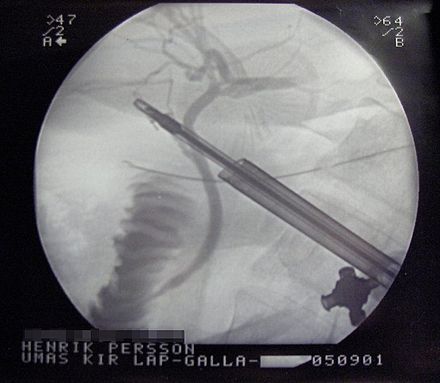Cholecystitis
Cholecystitis is the inflammation of the gallbladder, primarily caused by gallstones blocking the cystic duct. This condition predominantly affects adults and has a higher prevalence in women, particularly those over 40. The gallbladder can also become inflamed due to severe illness, vasculitis, or chemotherapy. If untreated, cholecystitis can lead to severe complications, including gallbladder rupture, gangrene, and fistula formation.
Signs and Symptoms
Cholecystitis often presents with intense right upper abdominal pain which can radiate to the right shoulder. Nausea, vomiting, and fever are common accompanying symptoms. The pain associated with cholecystitis is more severe and persistent than that of typical biliary colic, which is episodic and often triggered by fatty meals. Physical examination typically reveals tenderness in the midclavicular right lower rib margin, and in some cases, a palpable gallbladder. Murphy's sign, where deep inspiration worsens the pain during palpation of the right upper quadrant, is a key diagnostic indicator. Jaundice may occur but is usually mild unless complications like choledocholithiasis are present.

Complications
Cholecystitis can lead to several serious complications if not treated promptly. These include:
- Gangrene and Gallbladder Rupture: Decreased blood flow to the gallbladder can cause tissue death, leading to gangrene and potentially rupture, which is life-threatening.
- Empyema: Infection and pus accumulation in the gallbladder can result in high fever and severe abdominal pain.
- Fistula Formation and Gallstone Ileus: Inflammation can cause abnormal connections between the gallbladder and gastrointestinal tract, leading to intestinal obstruction by gallstones.
Causes
The primary cause of cholecystitis is gallstones, accounting for 90% of cases. Risk factors for gallstones include female sex, age, pregnancy, oral contraceptives, obesity, and diabetes mellitus. In some cases, cholecystitis can develop without gallstones (acalculous cholecystitis), often in critically ill patients. This form of cholecystitis is associated with high morbidity and requires prompt treatment.
Mechanism
The blockage of the cystic duct by a gallstone leads to bile buildup, increased pressure, and inflammation of the gallbladder. This can result in bacterial infection, further exacerbating inflammation and potentially reducing blood flow, leading to tissue death.
Diagnosis
Diagnosis of cholecystitis is based on clinical presentation, laboratory tests, and imaging studies. Laboratory tests typically show elevated white blood cell count and C-reactive protein, indicating inflammation. Bilirubin levels may be mildly elevated.
Imaging
Ultrasound is the primary imaging modality used to diagnose cholecystitis, revealing gallstones, pericholecystic fluid, and gallbladder wall thickening. Computed tomography (CT) and hepatic iminodiacetic acid (HIDA) scans can also be used, especially if complications are suspected.


Treatment
Surgery
The primary treatment for acute cholecystitis is laparoscopic cholecystectomy, performed within 24 hours if possible. This minimally invasive surgery has better outcomes than open cholecystectomy, including less postoperative pain and fewer complications. Early removal of the gallbladder within the first week of symptom onset is preferred.

Other Treatments
Supportive measures, such as fluid resuscitation and intravenous pain management, are essential. Antibiotics may be used to target enteric organisms if surgery cannot be performed immediately or if there are signs of severe infection. In cases where surgery poses a high risk, percutaneous gallbladder drainage might be considered, followed by delayed cholecystectomy once the patient's condition stabilises.

Self-assessment MCQs (single best answer)
What is the primary cause of cholecystitis?
Which population is most commonly affected by cholecystitis?
What is a key diagnostic indicator of cholecystitis during a physical examination?
Which imaging modality is primarily used to diagnose cholecystitis?
What complication involves the accumulation of pus in the gallbladder?
Which of the following is a common symptom of cholecystitis?
What is the preferred treatment for acute cholecystitis?
Which of the following is NOT a risk factor for gallstones?
Which complication involves the formation of an abnormal connection between the gallbladder and gastrointestinal tract?
What laboratory finding is commonly elevated in cholecystitis?
Dentaljuce
Dentaljuce provides Enhanced Continuing Professional Development (CPD) with GDC-approved Certificates for dental professionals worldwide.
Founded in 2009 by the award-winning Masters team from the School of Dentistry at the University of Birmingham, Dentaljuce has established itself as the leading platform for online CPD.
With over 100 high-quality online courses available for a single annual membership fee, Dentaljuce offers comprehensive e-learning designed for busy dental professionals.
The courses cover a complete range of topics, from clinical skills to patient communication, and are suitable for dentists, nurses, hygienists, therapists, students, and practice managers.
Dentaljuce features Dr. Aiden, a dentally trained AI-powered personal tutor available 24/7 to assist with queries and provide guidance through complex topics, enhancing the learning experience.
Check out our range of courses, or sign up now!


